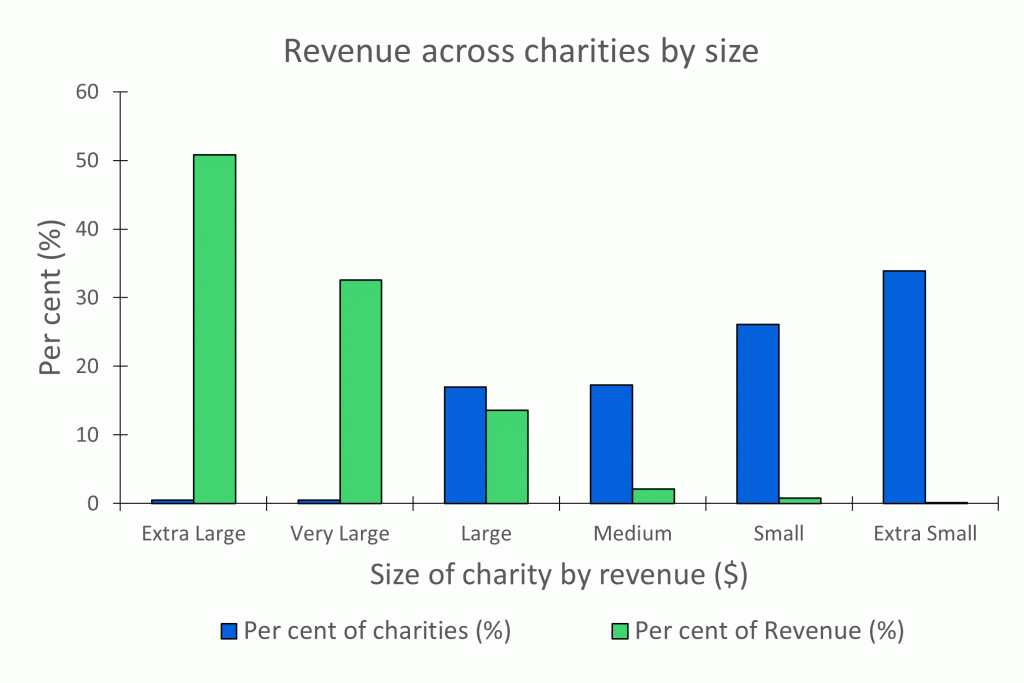Big vs Small Charities: The Funding Gap

When Vilfredo Pareto, an Italian economist, surveyed his country in the late 19th century, he found an unexpected distribution of land ownership: 20% of people owned 80% of the land. Formulated later by Joseph M. Juran, the Pareto Principle implies 80% of results are produced by 20% of causes. This has wide-ranging implications. In business, for example, it is generally observed that 80% of sales come from 20% of clients, and in fundraising, 80% of funds come from 20% of donors.
Of course these figures are not exact—the principle is more of a guideline than an actual rule. But one common pattern which is particularly relevant to the charity sector is the disparity between big and small charities. It’s not surprising that large charities in Australia receive a larger proportion of donations, but how big is the gap, exactly and can we do anything about it for the good charities which struggle?
Big vs Small
So what distinguishes a big charity from a small charity and what makes either of them good?
The Australian Charities and Not-for-profits Commission (ACNC) categorises charities by revenue: a large charity has over $1m in annual revenue, a medium charity between $250k and $1m, and a small charity receives less than $250k. Three further categories have been defined to help investigate the data: extra small charities (revenue <$50k), very large (>$10m) and extra large (>$100m).
According to the original ACNC categories, in 2018, 66% of charities were small (Small + Extra small), 16% were medium and 18% large (Large + Very Large + Extra Large; Figure 1).

Figure 1. The per cent of charities in each revenue size group and the percentage of the total revenue each group receives annually.
Charity Funding
Small charities make up around two thirds of all the charities in Australia and extra small charities make up around a third, but what does the distribution of charity funding look like?
By definition, individual medium and large charities receive more funding than individual small charities. Medium and large charities tend to draw in larger amounts in government funding and contracts than small charities, as they have the infrastructure to support administration, reporting and delivery of services on a larger scale (Dalton & Butcher, 2014).
Large charities overshadow small charities in terms of total revenue in Australia: the largest 23% of charities generate 97% of all charity revenue, while extra large charities (representing only 0.5%) make up 51% of the revenue (ACNC Charities Report, 2018; Figure 1).
When we look at charity revenue that comes from donations and bequests, i.e. money that individuals and companies donate, we see a similar distribution to that of total revenue. Donations accounted for only 7% of the charity sector’s total revenue in 2018. They made up 13% of large charities’ income, and 2.5% of extra large charities’, whereas donations to small charities accounted for 38%, a much greater share of their revenue. Small charities are more reliant on donations because they do not receive the same level of government funding as large charities. Despite this, the vast majority (86%) of all donations and bequests also go to large charities. In 2018, this constituted over $9b, out of a total donation pool of $10.5b. Small charities received $564m.

Figure 2. Revenue from donations and as a percentage (%) of the total revenue by charity size (n=>48k)
Small charities are both more reliant on donations and receive less. This has knock-on effects for extra small charities’ expenditure in particular—only 18.6% employ staff and the rest rely on volunteers to advance their mission.
Good Charities
People and companies tend to choose to give money to larger charities that enjoy name recognition and carry out their work at a state or national level. This makes sense, as we want to make sure our money is going to be used well and make a real difference, and our natural instinct is to assume bigger name brand charities will make the biggest difference.
But this is not always the case. There are many smaller good charities working at a community level that perform equally vital work but with much less funding.
At Giving Guide, we recognise the amazing work carried out by Australian charities of all sizes, across the country and around the world. We especially recognise the value smaller charities bring to your local community. They are no less worthy of support.
We have provided a platform that makes it easier to find detailed information about charities you may like to support—of any size. We want to connect you with charities that support causes you care deeply about, not just big name charities you may have seen ads for.
Try out our free search tools now to start looking for organisations in your community who help people and causes close to home, as well as close to your heart—whether large or small.
The long and short of it,
Guide
Share
About Us
Integrity, honesty and unbiased assessment are at the core of Giving Guide’s mission. The charity sector is important to the economy and culture of Australia, We believe independently assessing the accountability, transparency and effectiveness of the sector beyond what is currently available is important to it's future.
Giving Guide anticipates enhancing the level of governance and transparency in the Australian charity sector. An independent charity advisor would benefit the sector by helping charities consider exceeding the existing governance standards of the Australian Charities and Not-for-profits Commission (ACNC) to the benefit of donors.
More Articles
Let's change charity
Please get in touch and let us know your thoughts on how we can improve the charity sector in Australia.






